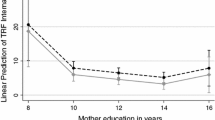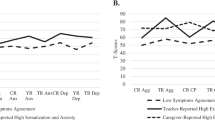Abstract
The purpose of this study was to examine the family environment and school functioning of adolescents who differed on level of internalizing problems as reported by the adolescent and her/his mother. Thirty-six adolescents, their mothers, and their social studies teacher served as participants. Three groups were formed based on the report of level of internalizing problems: high mother and adolescent report (high concordant); low mother/high adolescent report (discordant); and low mother/low adolescent report (low concordant). The results indicated that the high concordant group, but not the discordant group, differed significantly from the low discordant group in that adolescents from the former group were from home environments with more difficulties (more interparental conflict, maternal depression, & maternal anxiety) and had more internalizing problems and lower grades in school. The results point to the importance of parent-report data when clinically assessing adolescents or conducting research on internalizing problems of adolescents.
Similar content being viewed by others
References
Achenbach, T. M., & Edelbrock, C. S. (1978). The classification of child psychopathology: A review and analysis of empirical efforts.Psychological Bulletin, 85 1275–1301.
Achenbach, T. M., McConaughy, S. H., & Howell, C. T. (1987). Child/adolescent behavioral and emotional problems: Implications of cross-informant correlations for situational specificity.Psychological Bulletin, 101 213–232.
Beardslee, W. R., Bemporad, J., Keller, M., & Klerman, G. I. (1983). Children of parents with major affective disorder: A review.American Journal of Psychiatry, 140 825–832.
Beck, A. T., Steer, R. A., & Garbin, M. G. (1988). Psychometric properties of the Beck Depression Inventory: Twenty-five years of evaluation.Clinical Psychology Review, 8 77–100.
Csikszentmihalyi, M., & Larson, R. (1984).Being adolescent. New York: Basic.
Fauber, R., Forehand, R., Long, N., Burke, M., & Faust, J. (1986). The relationship of young adolescent Children's Depression Inventory (CDI) scores to their social and cognitive functioning.Journal of Psychopathology and Behavioral Assessment, 9 161–172.
Fauber, R., Forehand, R., Thomas, A. M., & Wierson, M. (1990). A mediational model of the impact of marital conflict on adolescent adjustment in intact and divorced families: The role of disrupted parenting.Child Development, 61 1112–1123.
Kazdin, A. E. (1981). Assessment techniques for childhood depression.Journal of American Academy of Child Psychiatry, 20 358–375.
King, N. J., Ollendick, T. H., & Gullone, E. (1991). Negative affectivity in children and adolescents: Relations between anxiety and depression.Clinical Psychology Review, 11 441–459.
Kovacs, M. (1981). Rating scales to assess depression in school-aged children.Acta Paedopsychiatrica, 46 305–315.
Loeber, R., Green, S. M., Lahey, B. B., & Stouthamer-Loeber, M. (1989). Optimal informants on childhood disruptive behaviors.Development and Psychopathology, 1 317–337.
Myers, J. K., & Bean, L. J. (1968).A decade later: A follow-up of social class and mental illness. New York: Wiley.
Porter, B., & O'Leary, K. D. (1980). Marital discord and childhood behavior problems in children.Journal of Abnormal Child Psychology, 8 287–295.
Quay, H. B., & Peterson, D. R. (1987).Manual for the Revised Behavior Problem Checklist. Unpublished manuscript, University of Miami.
Reynolds, C. R., & Paget, K. D. (1981). Factor analysis of the Revised Children's Manifest Anxiety Scale for blacks, whites, and females.Journal of Consulting and Clinical Psychology, 49 352–359.
Reynolds, C. R., & Paget, K. D. (1982, March).National normative and reliability data for the Revised Children's Manifest Anxiety Scale. Paper presented at the annual meeting of the National Association of School Psychologists, Toronto, Canada.
Reynolds, C. R., & Richmond, B. O. (1978). What I think and feel: A revised measure of children's manifest anxiety.Journal of Abnormal Child Psychology, 6 271–280.
Spielberger, C., Gorsuch, R., & Lushene, R. (1970).STAI Manual. Palo Alto, CA: Consulting Psychologists Press, Inc.
Strauss, C. C., Frame, C. L., & Forehand, R. (1987). Psychosocial impairment associated with anxiety in children.Journal of Clinical Child Psychology, 16 235–239.
Turner, S. M., Beidel, D. C., & Costello, A. (1987). Psychopathology in the offspring of anxiety disorders patients.Journal of Consulting and Clinical Psychology, 55 229–235.
Author information
Authors and Affiliations
Rights and permissions
About this article
Cite this article
Long, P., Forehand, R. & Wierson, M. Internalizing problems of adolescents: The role of the informant in identifying family and individual difficulties. J Child Fam Stud 1, 329–339 (1992). https://doi.org/10.1007/BF01321289
Issue Date:
DOI: https://doi.org/10.1007/BF01321289




